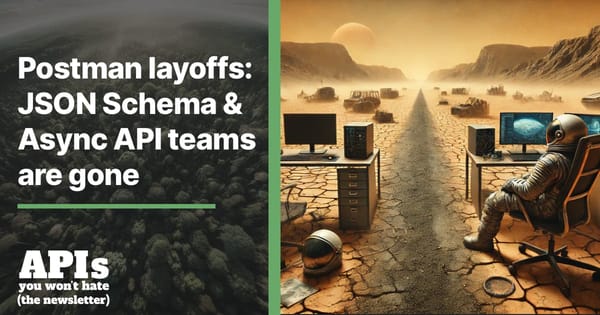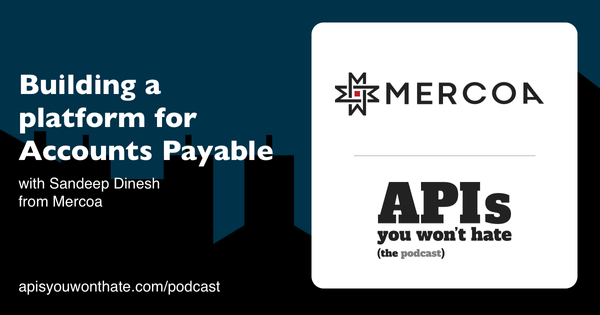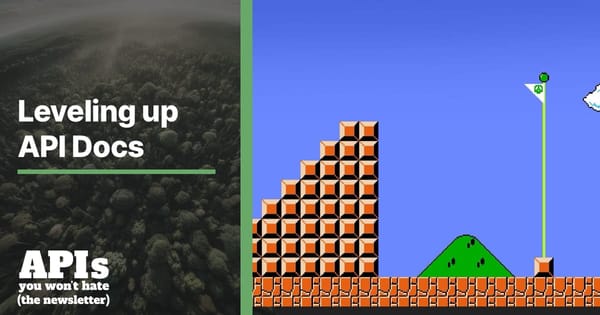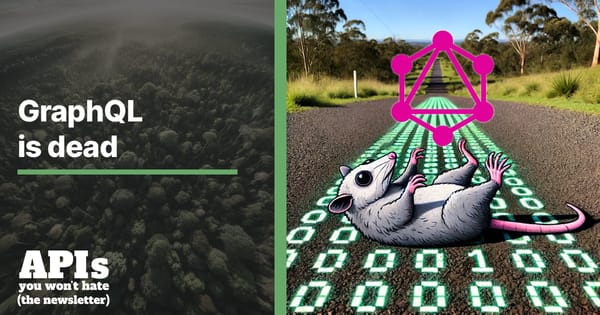Let's Stop Building APIs Around a Network Hack

JSON:API has been one of the most popular standards for
API development for a while now. It was conceived in 2013, battled through some
rather different RC versions (changing drastically as it went), finally
stabilizing with v1.0 back in mid-2015.
My interest in JSON:API has changed substantially over the years. Initially I
avoided it like the plague, later I recommended it, and now I generally suggest
folks skip it if at all possible.
Besides trying to standardize how you represent items, collections, meta data
and errors (an excellent goal!), it sets out to solve a lot of problems such as
Compound Documents.
The concept of a "compound document" — in the API world at least — is the art of
squashing related data into the main requested resources. This is done to reduce
the number of HTTP calls a client has to make.
Clients have for a long time been very unhappy making multiple HTTP/1.1 calls,
especially over mobile networks. That concern has had a noticeable impact on how
we design APIs. Multiple calls is considered a point of bad design, to the point
where fetching a user will include the companies they work for, and that
includes the locations a company might have, and that includes something else...
That was a bit of a mess, so conventions and standards were invented to make
those includes optional, and JSON:API was one of the main contenders.
Somewhere in 2013 I also released a tool called
Fractal, which was based off of code I'd
been running in production since early 2013. The goal there (other than
serialization) was the same thing, to facilitate embedding and nesting includes
optionally.
In 2013 this all made sense. Multiple calls were bad, so we had to reduce those,
without assuming too much and making our requests slower than they should be.
This continued to be valid for a long time, even in 2015 when JSON:API was
finalized.
Guess what else was released in May 2015? RFC 7540, otherwise known as
HTTP/2. In retrospect this seems highly
poetic, as HTTP/2 kinda makes the compound document aspect of JSON:API a little
bit pointless, and compound documents to me go hand in hand with what JSON:API
is as a standard.
Not to just pick on JSON:API, the same can be said about HAL, OData, and it also
makes Fractal's nesting/embedding feel silly, like it should be ripped out in a
future version.
What's the Difference?
There are plenty of resources out there explaining the differences between
HTTP/1.1 and HTTP/2, so I'll let them cover it.
The main point here is that HTTP/1.0 forces you to handle DNS, HTTP handshakes,
SSL negotiation, etc., on every single call, and if your homepage wants 10
things from the API then it's doing all of that junk 10 times... HTTP/1.1 actually
solved this with Connection: keep-alive, but not many people seem to use that. When
we enabled it at WeWork it sped up HTTP interactions by around ~10%, which was nice.
HTTP/2 not only maintains a single connection per domain for reuse, but these calls
can be handled asynchronously. For a blog website, you could requests articles, and
upon receiving those ask for the author information. Further callbacks may ask for
comments and then comment author information.
If you can use Server
Push then you don't
have to wait for the articles to arrive before you can request the author information.
The server will just start sending you the author information!
Seriously, HTTP/2 calling is fast.
Bla Bla Compound Documents. What else?
To me JSON:API has always mainly been about reducing the size of a payload
response via network hacks like compound documents, but there is another
strategy used. Sparse
Fieldsets — an idea
fairly fundamental to GraphQL also — lets clients specify the fields they're
interested in, so the API can send only those fields.
GET /articles?fields[articles]=title,body
Whilst sparse fieldsets can save a few kbs, there are plenty of other ways of
trimming down the size of the response.
The entire mindset of "more handshakes = bad" has forced us to shove fields into
the same resource to avoid making new resources, or sub-resources. Now that we
don't need to be scared of it, we can stop using hacks like the partials
trade-off
I recently proposed, and move towards having more resources that are a bit more
targeted in scope.
Invoices don't need payment status, or an array of order items, so we don't need
to worry about trimming down the response at the field level, they can just be
their own related resources, discoverable with hypermedia controls.
If splitting up resources sounds like a big change and you want to just squash
that actual response, HTTP/2 has your back there too. Headers are compressed
with HPACK, which is similar to GZIP but a little better, and it's something
Cloudflare are pretty excited
about.
That's not to mention that the whole protocol is binary instead of plain-text,
which gets you another nice boost. If you're still sad about JSON being slow,
you can use content-negotiation to add BSON or Protobuff to your REST API, which
is a large part of whats getting people so excited about gRPC.
In general, once again, the potential speed benefit of skipping a bit of that
JSON coming back using sparse fieldsets, seems to be lost in the idea of making
your API be less variable, having more targeted resources, which are drastically
more cacheable at the network level.
HTTP/2 Support in the Real World
NGINX already supports HTTP/2. Some
programming languages like Go have built-in HTTP/2
support, so you can enjoy the full benefits of
HTTP/2 like Server Push. NodeJS too.
Everyone else can at least leverage
multiplexing by
slapping Cloudflare, Fastly, etc., in front of their HTTP/1.1 setup.
But the Browsers...
Currently not 100% of browsers support HTTP/2 in its entirety, but the Modern browsers support
situation is pretty good.
HTTP/2, and these browsers are used by 88% of
users.
If your API is predominantly web-based, and older browser support is important,
or you have no idea which browsers are going to be hitting it, then maybe you
need to continue worrying about network hacks like compound documents.
The New World of API Design
Combining HTTP/2 with targeted, network cached endpoints (via Fastly, Varnish,
Squid, etc), makes Hypermedia Controls (HATEOAS) seem waaaaaaaay less silly.
I'm not waiting for a response before I see what actions I can take next,
that's slow! — Fictional Narrative Device
No longer! HTTP clients net-http2 in
Ruby make asyncing up your calls nice and easy, so you can run actions in
callbacks as soon as the responses come in.
Hypermedia in general seems a lot more viable when you're not terrified of the
transportation layer being slow.
It also means you're not going to be scared of making a sub resource. At work
right now we have GET /users and they want to shove "locations" in there
(every WeWork location that a user has access to).
That would be how you'd want to do it in 2014, but in 2017 that should be GET /users/123/locations or GET /locations?user_uuid=123, or who cares. It just
doesn't need to be jammed up in there, slowing everyone down, just in case
somebody needs it.
Includes, partials,
etc., can all graduate to being actual brand new requests, instead of being some
weird network hack because we were scared of handshake time.
But Adding This to REST Sounds Hard!
Folks often say "Why would I want to waste time making a REST API do this when I
could just use X."
In the same way that JSON:API feels a little silly to me now, it makes GraphQL
feel substantially less useful... Anything designed around this network hack no
longer feels as useful as it once was.
Well, GraphQL is the king of all glorified network hacks, and gRPC is literally
just HTTP/2 + Protobuff, I'm left realizing these little niche API setups are
not quite as useful as their marketing sites are making out.
If you already have a REST(ish) API, you can just start using HTTP/2 right now
and get half the benefits of gRPC, and no longer care about many of the
benefits of GraphQL (which are mostly available for HTTP APIs anyway).
Maybe you can remove the "ish" from your RESTish APIs by focusing more on your
API as a state machine now that you're not quite as scared of making more HTTP
calls.
Summary
These previous solutions were far from perfect, and I'm going to write about
real-world issues I've struggled through with compound documents in the next
article
(done!).
I don't think anyone should rush out and change everything right now, but
recognize the changing environment around the web.
As the web evolves the standards evolve to meet changing requirements, and as
they evolve we no longer need as many hacks to get the job done. Frontend
developers aren't make CSS image sprites
anymore,
and JS/CSS combination is going away too.
HTTP/2 is a representation of what developers needed, and now we can use HTTP in
its entirety, without needing so many network hacks to make it performant enough
to get the job done.
Using JSON:API/HAL/OData is a fine way to go about building HTTP/1.1-based APIs,
and it's better than inventing your own approach to compound documents, but do
you really need to building HTTP/1.1-based APIs, or is it just inertia?





